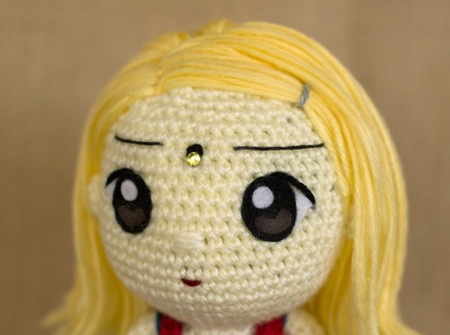I had several messages from people who would like to crochet amigurumi items based on patterns but still have difficulty understanding the technical terms and abbreviations. I have been there, my first project was a little bear which ended looking like a voodoo doll because I had no clue what I was doing. The instructions looked like special codes and cipher from some James Bond flick and I wasn’t about to save the world with my crochet hook. I was very discouraged and for a while, I stopped trying. I learned, eventually, but it took me a lot of efforts to get started.
I am going to base these instructions on the way I write my own patterns, starting with the abbreviations. Patterns start with the list of materials you will need, and in most cases the type of crochet stitches you are going to use. Here a the basic ones:
rnd: round
sc = single crochet
dc = double crochet
hdc = half double crochet
st = stitch
sl st = slip stitch
ch = chain
inc = increase
dec = decrease
beg = beginning
blo = back loop only
flo = front loop only
Most amigurumi start with a magic ring, so in most cases, you will be asked to make one. Here is a very good video by June Gilbank that shows you how to make one and its purpose:
Now that you know what a magic ring is made, here is a sample from one of my pattern to make a ball:
Make a magic ring,
Rnd 1: 6 sc in center of the ring (6)
You make 6 single crochet in the ring you just made (this step is explained in the video). The (6) is the number of stitches you end up with when you finish the round.
Rnd 2: 2 sc in each st around (12)
You make 2 single crochet in every 6 stitches of the last round. At the end of this row, you should have 12 stitches.
Rnd 3: [1 sc, inc] 6 times (18)
This is what the instructions would be without abbreviations:
“1 single crochet, increase – 1 single crochet, increase – 1 single crochet, increase – 1 single crochet, increase – 1 single crochet, increase – 1 single crochet, increase.”
You repeated the process of one single crochet and one increase 6 times. Once you finish this round you end up with 18 stitches
Rnd 4: [2 sc, inc] 6 times (24)
“1 single crochet, 1 single crochet, increase – 1 single crochet, 1 single crochet, increase – 1 single crochet, 1 single crochet, increase – 1 single crochet, 1 single crochet, increase – 1 single crochet, 1 single crochet, increase – 1 single crochet, 1 single crochet, increase “
Similar to the previous round but you make 2 single crochet and one increase 6 times. Once you finish this round you end up with 24 stitches.
Rnd 5 to 9: sc in each st around (24)
For the next 5 rounds, you will just single crochet in each stitch. You will end up with the same number of stitches at the end.
Rnd 10: [2 sc, dec] 6 times (18)
This is what the instructions would be without abbreviations:
“1 single crochet, 1 single crochet, decrease – 1 single crochet, 1 single crochet, decrease – 1 single crochet, 1 single crochet, decrease – 1 single crochet, 1 single crochet, decrease – 1 single crochet, 1 single crochet, decrease – 1 single crochet, 1 single crochet, decrease.”
On this round, you made 2 single crochet and one decrease 6 times. You end up with 18 stitches at the end of your row.
Rnd 11: [1 sc, dec] 6 times (12)
“1 single crochet, decrease – 1 single crochet, decrease – 1 single crochet, decrease – 1 single crochet, decrease – 1 single crochet, decrease – 1 single crochet, decrease.”
On this round, you made 1 single crochet and one decrease 6 times. You end up with 18 stitches at the end of your row.
Rnd 12: dec 6 times (6)
Fasten off.
You decrease 6 times and end up with 6 stitches at the end of this round.
Cut your yarn and pull it with your hook.
Now that your ball is finished and stuffed with fiberfill, how do you close it? You still have 6 stitches left. In order to do that you will use your remaining thread and a needle. Insert your needle and thread in the front loop of each stitch of the last row and pull your string, this process with close the hole. You can hide the rest of the thread by weaving it between stitches of the ball.
Starting your round with a chain instead of a magic ring
There are cases where a pattern will ask you to start with a chain to start your first round, here is an example:
5 in ch,
Rnd 1: sc in second ch from hook, 2 sc, inc, turn, 2 sc, inc (9)
This is what the instructions would be without abbreviations:
Make 5 stitches to make a chain,
“single crochet in the second chain from the hook, single crochet, single crochet, increase, turn to the other side of the chain, single crochet, single crochet, increase.”
This one sounds a little bit more complex so I added a visual to understand the process:

I hope this helps a little, not everybody writes patterns the same way so I don’t expect to have solved all the difficulties one might run into while reading a pattern. But if you have any questions, or things you would like me to add to this post let me know in the comments.
Happy crocheting!





















































